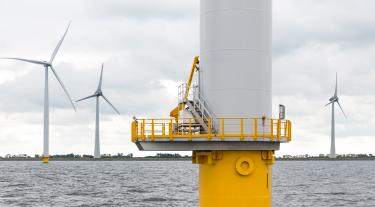Summary
- Increasing pile dimensions requires a better understanding of installation risks.
- The risk of potential pile-tip buckling is a driver for larger pile wall thicknesses on monopiles.
- Research aims to reduce wall thickness and therefore costs, plus allow for safe and optimised structures.
A collaborative project designed to investigate the effect of increased monopile size on the stability of the structures is underway. The Verification of Buckling Assessment and Behaviour in Large Monopiles (VERBATIM) project is a €3 million joint industry initiative, due to be completed by early 2023.
Currently, the predominant substructure for offshore wind turbines is the monopile foundation. As turbines continue to get bigger, the supporting monopiles become larger in size with diameters beyond 10m and lengths over 60m. These large monopiles have a higher risk of buckling below the seabed as the impact hammers used for installation and the forces exerted on the monopile have increased. To mitigate this potential risk, the industry has adopted greater wall thickness.
Increasing understanding of how monopiles behave during installation, and the potential defects that may reduce the lifetime of an offshore wind asset, could result in reduced wall thickness allowing safe, optimised structures, whilst also lowering costs.
Developers have to ensure that a monopile can be driven into the seabed without creating any structural defects. To date, current design practices have ensured successful pile installation without pile-tip buckling or refusal. As monopiles become larger, the development of an enhanced design procedure to deliver safe and cost-effective foundations becomes increasingly important. Pile buckling has to be prevented as a key priority, using economic and time efficient methods.
With majority funding from the German Federal Ministry of Economics and Energy (BMWi), the project is part of the 7th Energy Research Programme of the German Federal Government, administrated by Projektträger Jülich (PTJ). The VERBATIM project further benefits from strong technical and financial industry support provided by the Offshore Wind Accelerator partners: EnBW, Equinor, RWE, Ørsted, Scottish Power Renewables, Shell and Vattenfall.
The project is being conducted by BAM, German’s Federal Institute for Materials Research and Testing, the Technical University of Berlin and JBO with support from the Carbon Trust, bringing together a range of experience and expertise in mathematical modelling, scale laboratory testing, large-scale field testing and project management.
VERBATIM is investigating potential pile-tip buckling phenomena during installation and buckling instabilities of the embedded pile near the mud-line. The objectives are to:
- Conduct analysis of conditions for pile buckling
- Develop and validate a Finite Element (FE) model and benchmarking study
- Develop a design procedure for pile embedment and stability checks
- Optimise pile design
- Consider economic and ecological aspects
- Develop technical design rules for piles
BAM’s project coordinator, Dr. Matthias Baessler commented:
“As turbine size and water depths increase, the dimensions of monopile foundations continue to grow and we are now dealing with diameters of 10m or more. To install them safely and cost-efficiently we need verified calculation models. Therefore, in VERBATIM we are specifically investigating the conditions for pile buckling.”
The Carbon Trust’s project manager for VERBATIM, Dr James Sinfield added:
“The VERBATIM project comes at an important time for the offshore wind industry. With monopiles becoming ever larger, we need to ensure that turbines are installed on solid foundations; the involvement of the Offshore Wind Accelerator partners in this project will ensure that the impact of the results are maximised and that new guidelines and best practice will be implemented quickly.”
Verification of buckling assessment and behaviour in large monopiles
ENDS
Notes to editors
For further information please contact:
The Carbon Trust press office on +44 (0) 20 7170 7050 or press@carbontrust.com.
About the OWA
The Offshore Wind Accelerator (OWA) is the Carbon Trust's flagship collaborative research, development and deployment programme. The joint initiative was set up between the Carbon Trust and nine offshore wind developers in 2008, with the aim to reduce the cost of offshore wind to be competitive with conventional energy generation, as well as provide insights regarding industry standard (and best practice) health and safety requirements.
The current phase involves participation and funding from nine international energy companies: EnBW, Equinor, Ørsted, RWE Renewables, ScottishPower Renewables, Shell, SSE Renewables, Total and Vattenfall, who collectively represent 75% of Europe’s installed offshore wind capacity.
About the Carbon Trust
Established in 2001, the Carbon Trust works with businesses, governments and institutions around the world, helping them contribute to, and benefit from, a more sustainable future through carbon reduction, resource efficiency strategies, and commercialising low carbon businesses, systems and technologies.
The Carbon Trust:
- works with corporates and governments, helping them to align their strategies with climate science and meet the goals of the Paris Agreement
- provides expert advice and assurance, giving investors and financial institutions the confidence that green finance will have genuinely green outcomes
- supports the development of low carbon technologies and solutions, building the foundations for the energy system of the future.
Headquartered in London, the Carbon Trust has a global team of over 200 staff, representing over 30 nationalities based across five continents.


